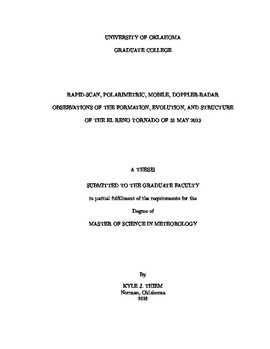| dc.description.abstract | On 31 May 2013, the mobile, Rapid-scan, X-band, Polarimetric (RaXPol) radar collected a high spatial and temporal resolution dataset documenting the genesis, intensification, and dissipation of a tornado that caused EF-3 damage (indicating wind speeds of at least 61−73 m/s) near El Reno, OK, although Doppler velocities measured by RaXPol exceeded 135 m/s near the surface. The RaXPol mobile radar was deployed three times during the tornadic phase of this storm between 4.5−11 km from the center of the tornado and collected 360◦ PPI scans every 2 s with range gate spacing between 45−15 m.
The evolution of the Doppler-velocity field before and after tornadogenesis was analyzed to investigate the genesis process. Reconstructed vertical cross-sections taken through the center of the tornado reveal fine-scale details about the vortex structure and how it evolves throughout the tornado’s life cycle. The tornado then grew rapidly to an unprecedented width and underwent at least one transition from a single-vortex structure to a multiple-vortex structure. Within the Doppler velocity data, multiple subvortices were resolved during the large, multiple-vortex phase of the El Reno tornado’s life cycle, over a time period of 132 s. Details about the origins, paths, and dissipations of at least two-dozen resolvable subvortices, some of which had translational speeds in excess of 75 m/s, were documented. The subvortices mostly developed inside the radius of maximum winds and those that persisted for longer periods of time (>15 s) tended to traverse towards the center of the tornadic vortex over their life cycles. Details regarding the evolution and kinematics of the subvortices were compared to composite background fields of radial velocity and spectrum width to draw conclusions regarding the areas of common subvortex genesis and dissipation. Azimuthal velocities of the subvortices will also be compared to the background radial velocity field to determine if they were retrograding with respect to the mean flow, as tornado vortex theory would suggest. Finally, a rapid transition from a large, broad vortex to a small, tight vortex observed in the Doppler velocity and cross-correlation coefficient fields will be discussed along with the simultaneous existence of an anticyclonic tornado and its connection to the rear-flank gust front. | en_US |
